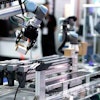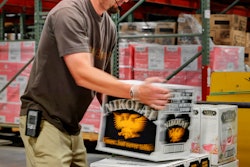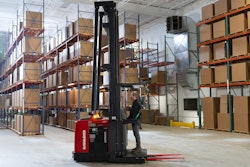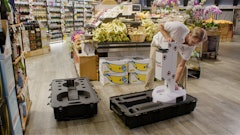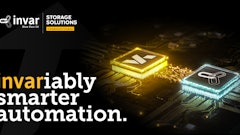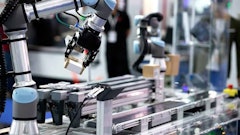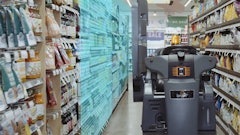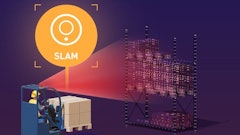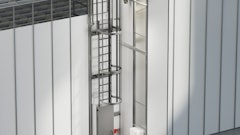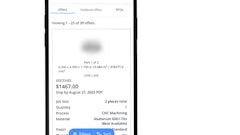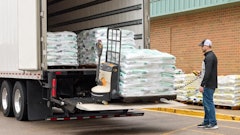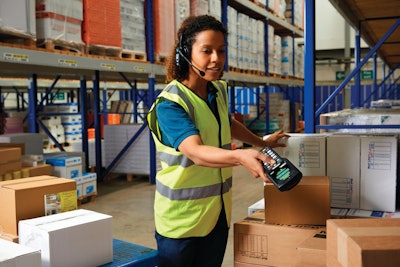
When asked what warehouse technology brings the most immediate improvement in efficiency, voice picking often comes to mind for warehouse operations professionals. The ability to guide the picker through an order, provide item location and quantity required, then have the action confirmed by voice makes a distribution warehouse more efficient. And given that order picking can account for 40 to 60 percent of the labor in a food or beverage warehouse, this benefit remains a driving force for voice automation.
By using a voice verification system, information from the WMS is transformed to speech, instructing the order picker to the item location and quantity required. The picker then verbally confirms the location via a number, or check digit, located where the product is stored and the quantity picked.
Verbal confirmation, while not taking the picker’s eyes off of the activity performed, increases the picker’s accuracy and productivity.
But as warehouse management software (WMS), voice verification technology and computer hardware all evolve, system integrators are finding new ways to expand voice technology’s benefits beyond that of order picking. State-of-the-art voice picking systems include bar code scanning to create new processes that optimize user productivity and accuracy.
While this article focuses on voice technology’s growing capabilities and the choices that it offers warehouse managers, it is important to note that order picking remains the key benefit that voice technology provides, given the importance of this function in a distribution warehouse. As noted above, the order picking function accounts for 40 to 60 percent of total warehouse labor hours.
It must also be noted that voice technology is not the only order picking system that distribution warehouses currently use. Radio frequency (RF) scanners and pick-to-light systems are also being used, both of which have begun using visual logistics to make the order picker’s job easier than text messages.
Warehouse managers are advised to consider all options when choosing an order picking technology.
Marc Wulfraat, president of the Montreal, Canada-based consultancy MWPVL International, claims that voice-directed picking applications have among the highest rates of order picking accuracy. But he also notes that there is a blending of technologies taking place; voice picking can be combined with RF scanning and with forthcoming visual technologies to enhance the solution to include data capture requirements.
Wyoming Liquor: full- and split-case orders
The Wyoming Liquor Division faced a demand for a larger inventory of items available for overnight delivery and expanded the special order and catalog sections at its Cheyenne, Wyo. distribution center. Its manual paper pick order fulfillment system was unable to adapt to the shifted retailer preference from full cases or pallet loads to more complex split-case orders.
The division found the Datria Voice solution from Elmsford, N.Y.-based Knighted, an Intelligrated company, offered pick-by-voice order fulfillment featuring hands-free, step-by-step picking instruction and real-time order management. Wireless phones and Bluetooth headsets replaced paper pick lists, and enabled the WMS to direct workers to each item location for accurate item picking, improved efficiency and accuracy.
The Datria voice system is configured to manage both full- and split-case order picking. Employees use wireless devices to connect to the WMS and begin a back and forth dialogue, verifying completion each step of the way until the order is concluded. After directing the picking sequence to completion, the Datria system automatically updates the order status in the WMS.
The increased order fulfillment capability allows Wyoming Liquor to ship more than 3,000 full cases and 12,000 bottles per day. This represents a 15 percent productivity increase over the legacy process, with an order accuracy rate of 99.9 percent, according to the division.
Functions beyond picking
Meanwhile, voice technology has expanded to improve warehouse operating efficiencies in areas other than product picking.
Voice recognition software can manage the following functions: selection (case, piece batch and cluster picking), put-to-store (building location specific pallets, both single and multi-SKU pallets), replenishment, transfers (point-to-point item moving), put-away, line loading (order assembly from belts for pallet building), cycle-counting, loading, back stocking, receiving and inventory control.
Jay Blinderman, director of product marketing at Vocollect by Honeywell, notes that accurate cycle counting can eliminate the need for a stand-alone inventory audit function.
Nature’s Best, the Brea, Calif.-based natural foods wholesaler, uses the Vocollect voice system to direct lift trucks in addition to picking orders in the warehouse. Brian McCarthy, senior vice president of operations at Nature’s Best, looks forward to having his pickers scan case UPC codes and verbally confirm case weights. He sees this as especially helpful in managing fresh food, where code dates are critical to both customer satisfaction and reducing product waste.
Combining bar code scanning and voice
The marrying of bar code scanning and voice – so-called multi-modal applications – marks one of the most recent advances in warehouse management, voice technology providers and integrators agree.
Jennifer Lachenman, vice president of product strategy and business alliances at Lucas Systems, a voice technology provider, notes that more than 80 percent of all new Lucas customers are using scanning within their voice applications.
Meanwhile, voice technology providers are making their software more “hardware agnostic.”
“We can use any hardware that’s voice-capable, including industrial PDAs and smart phones,” says Marceline Absil, vice president of sales and marketing at TopVOX Corp., a maker of voice hardware and software.
The TopVOX “speaker independent” speech recognition engine allows the system to recognize people’s voices without the need for lengthy voice template training. This greatly reduces training time and ensures that voice users are up and running in a timely manner, Absil says.
For Nature’s Way Products Inc., a manufacturer and distributor of dietary supplements based in Green Bay, Wis., the “speaker independent” feature was an important consideration in choosing a voice technology for the company’s new West Coast distribution center in McCarran, Nev., according to Tom Krajewski, Nature Way’s director of distribution.
Like McCarthy at Nature’s Best, Krajewski at Nature’s Way Products has used voice verification for functions other than order picking; packing and shipping are also voice-directed.
Numina Group, the Woodridge, Ill.-based logistics integrator, orchestrated the voice-directed processes for Nature’s Way. Numina Group’s warehouse control system (WCS) manages the order fulfillment automation module. The WCS simultaneously processes the entire mix of order types including split-case orders, Internet and less-than-truckload (LTL) shipments.
Motorola Solutions recently introduced a new solution called TekSpeech Pro which offers speaker independent voice recognition and requires no speaker training for easy and fast deployment. A speech analyzer captures all types of time and event information from voice-directed processes, providing the user visibility to maximize workflow and worker productivity.
Enabling product traceability
The combination of voice and scanning also promises to play an important role in efforts to improve product traceability, especially as government mandates become stricter and companies pay more attention to product handling. “Voice handles special instructions very well,” notes Lucas System’s Lachenman.
Food manufacturers and retailers have been at the forefront of efforts to improve traceability “from farm to fork.” In foodservice, the GS1 Foodservice Initiative, a voluntary effort among manufacturers, distributors and operators to improve supply chain efficiency and product traceability has given new impetus to voice and scan verification in that sector as well, Lachenman notes. In addition to improved traceability, GS1 and other standards efforts serve a dual purpose of improving supply chain efficiency by creating agreed data standards and communication protocols.
The Produce Marketing Association’s Produce Tracking and Tracing Initiative (PTI) suggests use of a standard label that includes the Global Trade Item Number (GTIN), lot number, country of origin and voice pick code, says Vocollect’s Blinderman. Voice technology enables the order selector to read two or four digits at the time the product is selected, saving time, improving accuracy and enabling the PTI goal of identifying the product and speeding product removal when needed. Many retailers already require this PTI label on inbound produce, he notes.
In addition, proposed requirements under the Food Safety Modernization Act (FSMA) also give new urgency to scanning and picking technologies, says Blinderman. He says the FSMA may prevent certain types of products from being together on the same pallet. Voice technology can assist in the efficient pallet build, while also providing a manufacturer or retailer with a record to track and trace an order and to see how a pallet was built.
Computer hardware evolves
As warehouse managers find new uses for voice verification, computer hardware continues to evolve, bringing new management tools to the warehouse. These include smart phones, “smart watches” and visual display technology (“Google glasses” is the best known example of visual display technology). Hence, warehouse managers must consider software/hardware compatibility to be in a position to take advantage of new hardware tools.
The food and beverage industries, like other industries, are taking direction from rapid advances in consumer electronics.
Lucas Systems recently certified Samsung Galaxy S4 smart phones for its software, Lucas’ Lachenman says. “Technology in the consumer space is impacting the industrial mobile worker,” she says. “More and more, technology developments in the consumer world is impacting the industrial world.”
But wait – won’t a smart phone in the warehouse require a picker to once again have to hold something in his hand? Rapidly-evolving consumer product technology has already provided answers.
Have you heard of the “smart watches” from Samsung and LG that deliver text and graphics and voice recognition software to your wrist?
“All of that (the use of smart phones with voice recognition along with smart watches to display other information) is enabled through our multi-modal software,” Lucas’ Lachenman says.
But it doesn’t end there.
Lucas has evaluated the use of “heads up” display technology in warehouse logistics applications, using a wearable computer that pairs voice and heads-up display technology. This technology has been referred to as “smart glasses” (Google glasses being the best known example.) Users can receive visual cues and information – product image, list of pick locations and quantities, etc. – without the need to take their eyes away from their task.
Smart glasses maker Vuzix and enterprise software firm SAP are marketing an augmented reality offering designed for distribution warehouses In a demonstration video, a forklift operator sees and hears picking instructions through his smart glasses. The operator is directed to pick a product in a specific aisle and row. As he nears the pick location, a green rectangle appears to highlight his destination. When the operator picks the item, a built-in scanner verifies that the operator has the right package, then directs him to the next pick or the loading dock.
Vocollect’s Blinderman says one of the major benefits of voice in the warehouse is allowing the worker’s hands to remain free. Google Glass might have potential to provide a similar benefit, however, the business challenge to be answered is how that type of display might enable a warehouse worker to perform distribution center functions faster and more accurately.
As hardware and software both advance, warehouse managers have to consider hardware/software compatibility. Providers of voice verification software increasingly note the importance of “hardware agnosticism.”
Order picking, meanwhile, remains the key benefit that voice technology provides, given this function’s importance in a distribution warehouse.
INFOBOX
For more information:
Intelligrated, intelligrated.com, 877-315-3400
Lucas Systems, Lucasware.com, 724-940-7000
MPVL International, mwpvl.com, 514-482-3572
Product Marketing Association, pma.com, 302-738-7100
Motorola Solutions, Motorolasolutions.com, 631-525-2139
Numina Group, numinagroup.com, 630-343-2600
SAP, SAP.com, 866-681-6121
TOPVox, top-vox.com, 847-842-0900
Vocollect, vocollectvoice.com, 412-829-8145
Vuzix, vuzix.com, 585-359-5900



